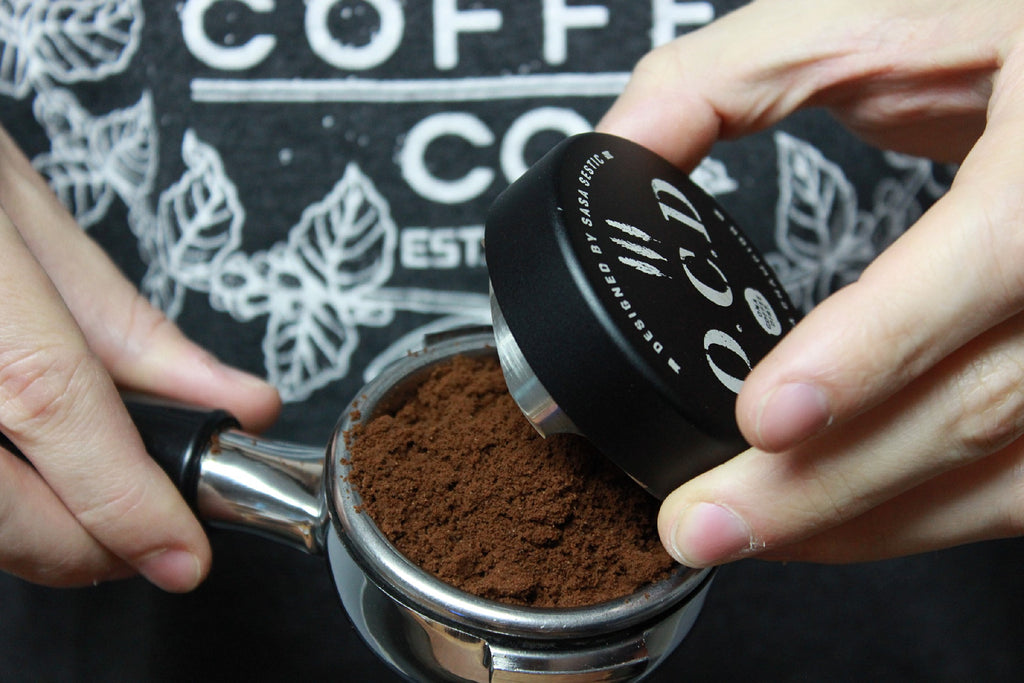The ONA Coffee Distributer: A Review, Observations, and Philosophical Ramblings
•Posted on March 30 2016
The ONA Coffee Distributor (or OCD) is a tool initially conceived of in 2012 and created by Sasa Sestic, the 2015 World Barista Champion. The OCD creates an even, flat bed of espresso to tamp on by being placed onto an undistributed dose of espresso in a portafilter, resting on the sides of the filter basket to flatten the device, and spinning it three times. That's it. It's a super-simple, fast, and easily-repeatable process for amazingly good coffee distribution. In order to fully appreciate what the OCD does, you'll need to appreciate the importance and difficulty of distribution for espresso. Distribution is what must happen after coffee has been ground and dosed into a portafilter. In order to make a great shot of espresso, one must spread out that uneven hill of freshly ground coffee into an evenly distributed bed of coffee that will then get tamped flat. Distribution is very, very important to the success of a shot of espresso. Wildly important. It's more important than exact tamping pressure, and possibly even more important than tamping levelly! If one fails to distribute evenly, the coffee will be pressed down in such a way as to create a puck of varying density. Even though it looks flat and pretty, when hot water gets forced through it more water will move through the less dense places and less water will move through the more dense places, yielding a shot that's a mish-mash of under-extracted and over-extracted flavors. In short, distribution in important because even distribution leads to even extraction. And even extraction leads to great tasting espresso.
There are a variety of techniques for the even distribution of coffee in a portafilter. Everything from pushing the coffee every which way with one's fingers, tapping the sides of the portafilter to lay the coffee flat, and even using a metal funnel that sits inside the portafilter whirling it the whole thing about like a helicopter. While some techniques are better than others, all these are flawed in the sense that they rely on sight and the individual. No one can really “see” the exact relative density of the espresso bed or whether or not there are any hidden pockets in it before it's tamped. And if I distribute one shot particularly well, it doesn't mean that the next shot will be distributed just as well. And I won't distribute in quite the same way as my co-worker; our fingers are shaped differently, we tap differently, and whirl things about differently. For that matter, I don't push, tap, or whirl quite the same way twice. See the problem? The OCD removes these errors and inconsistencies completely. When used properly, it provides an even distribution the exact same way each and every time, regardless of who's using it. And that's huge. There are few things worse for a cafe than to have customers who hesitate to purchase a drink one day because Steven isn't working the bar and Steven is the only one who can make their drink properly. The OCD helps everyone get on Steven's level.
Also, you who are cafe owners, consider employee turn-over. Proper espresso techniques like distribution are difficult to teach and master. It just makes sense to invest a small amount once on a tool that will help insure that “the new guy” performs nearly as well as the veterans, right?
This leads to my vaguely philosophical ramble. I was initially very sad after using the OCD. You see, during my stint as a barista I worked very long and very hard to perfect my espresso techniques, including distribution, and suddenly I'm handed a tool that does it just as well or better than I do every time and also lets any shmuck using the tool to do the same??!! I wanted to fight the OCD, but the results were impossible to ignore: the time it took for the streams coming from our bottomless portafilter to gather together fell from an average 18-20 seconds to 11 seconds every time, and the espresso was sweeter, more complex, and fuller in body. (In laymens, the espresso tasted way better with the OCD.) After whining about it to myself for a little while, I now wholeheartedly support the and fully recommend it for cafe use and espresso makers that want the best espresso every time. Here's why:
At BeanFruit, we use the OCD (in conjunction with the Big Step tamp and VST filter baskets) to largely remove the errors, wasted time, and wasted coffee associated with testing our espressos. Our Confection Espresso Blend has already been improved in part thanks to its help. In a sense, we're removing the distractions from good espresso. And that's why I didn't like the OCD. My pride was a dstraction. Concern for me making a better tasting shot than my co-worker was a terrible distraction. And the desire to see how consistent I could be without using an “extra tool” was a distraction. These all all distractions from the end goal; everyone making and being served great tasting espresso every time.

(That said, it's worth noting that the OCD won't make a professional out of a initiate, either. It won't weigh your shots, tamp evenly for you, clean and maintain your equipment or magically fill your head with coffee knowledge. It merely closes the gap between the two a bit more.)
So, now that we're free from distractions, what's next? Everything else. We're happily exploring the nature of ratios of coffee to espresso, how roast degrees effect the results, what blends and single-origin coffee's make for the best espressos, ect., all without so much of the burdens of improper technique. We're a better company for using the OCD, and we're offering better products in part because of it.
~ Written by William "Tony" Peacock

Comments
0 Comments
Leave a Comment